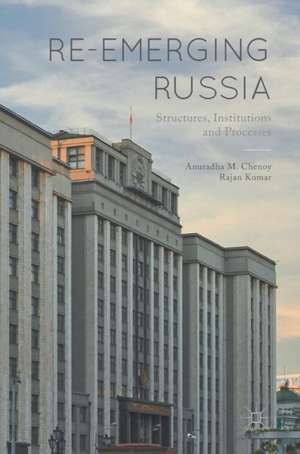Re-emerging Russia: Structures, Institutions and Processes
Autor Anuradha M. Chenoy, Rajan Kumaren Limba Engleză Hardback – 21 sep 2017
| Toate formatele și edițiile | Preț | Express |
|---|---|---|
| Paperback (1) | 725.13 lei 6-8 săpt. | |
| Springer Nature Singapore – 12 dec 2018 | 725.13 lei 6-8 săpt. | |
| Hardback (1) | 730.35 lei 6-8 săpt. | |
| Springer Nature Singapore – 21 sep 2017 | 730.35 lei 6-8 săpt. |
Preț: 730.35 lei
Preț vechi: 890.66 lei
-18% Nou
Puncte Express: 1096
Preț estimativ în valută:
139.77€ • 145.38$ • 115.39£
139.77€ • 145.38$ • 115.39£
Carte tipărită la comandă
Livrare economică 14-28 aprilie
Preluare comenzi: 021 569.72.76
Specificații
ISBN-13: 9789811052989
ISBN-10: 9811052980
Pagini: 292
Ilustrații: XVII, 292 p. 19 illus.
Dimensiuni: 148 x 210 x 25 mm
Greutate: 0.52 kg
Ediția:1st ed. 2017
Editura: Springer Nature Singapore
Colecția Palgrave Macmillan
Locul publicării:Singapore, Singapore
ISBN-10: 9811052980
Pagini: 292
Ilustrații: XVII, 292 p. 19 illus.
Dimensiuni: 148 x 210 x 25 mm
Greutate: 0.52 kg
Ediția:1st ed. 2017
Editura: Springer Nature Singapore
Colecția Palgrave Macmillan
Locul publicării:Singapore, Singapore
Cuprins
List of Graphs. - List of Tables. –Preface. -Chapter 1: The Disintegration of the Soviet Union: Systemic Change and the Systematic Collapse. -Chapter 2: The Constitution of Russia: Genesis, Features and Political Implications. -Chapter 3: The Formation of the Federation and Regional Politics. -Chapter 4: The Presidency and Presidential Power. -Chapter 5: Political Parties and Elections. -Chapter 6: Economic Transition and State Capitalism. -Chapter 7: The Changing Russian Society. -Chapter 8: Foreign Policy of Russia: Capitulation to Re-assertion. -Chapter 9: Conclusion: Russian Democracy and its Paradoxes.
Notă biografică
Anuradha M. Chenoy is professor in School of International Studies (SIS), Jawaharlal Nehru University, New Delhi, India. She has been the chairperson and area studies director in the Centre for Russian and Central Asian Studies, and Dean of SIS. She is the co-author of the book: The Maoist and Other Armed Conflicts (2010); and co-authour of Human Security: Concept and Implications (2006). Her other books are: Militarism and Women in South Asia (2002); The Making of New Russia (2001). She has done short term consultancies with organizations like the International Committee of the Red Cross, UNESCO and Action Aid International. She was a member of the Expert Group on Women Peace and Security of UN Women in South Asia.
Rajan Kumar is associate professor in the Centre for Russian and Central Asian Studies, School of International Studies,Jawaharlal Nehru University, New Delhi, India. His areas of interest include: society and politics in Russia and Central Asia; theories of international politics; research methods; India’s foreign policy. He has authored a book, Ethnicity, Nationalism and Conflict Resolution: A Case Study of Chechnya (2006). He has published a number of articles in national and international journals on these issues.
Rajan Kumar is associate professor in the Centre for Russian and Central Asian Studies, School of International Studies,Jawaharlal Nehru University, New Delhi, India. His areas of interest include: society and politics in Russia and Central Asia; theories of international politics; research methods; India’s foreign policy. He has authored a book, Ethnicity, Nationalism and Conflict Resolution: A Case Study of Chechnya (2006). He has published a number of articles in national and international journals on these issues.
Textul de pe ultima copertă
This book examines the evolution, contexts and politics of the structures and institutions that shape contemporary Russia. It analyses the Soviet dissolution, revealing the combination of structural and agency factors. It traces the re-emergence of Russia from a unique perspective that is neither Western nor Eurasian, but specifically Indian, located in the global South. The book looks at key theoretical concepts and practices like democratic centralism that produced an overly centralised and rigid hierarchy within the Communist Party. This book assesses the continuities and changes with the Soviet past and the way the Russian regimes of the past two decades have reinvented and reshaped them. This book provides a multifaceted interpretation of contemporary Russia for general readers and specialists.
Caracteristici
Discusses the structures, institutions and processes that evolved after the dissolution of the Soviet Union Analyses federal and regional structures to reveal the formal power arrangement Begins with the dissolution of the Soviet System, discusses political and social institutions, and ends with a section on Russia’s current foreign policy Includes supplementary material: sn.pub/extras
